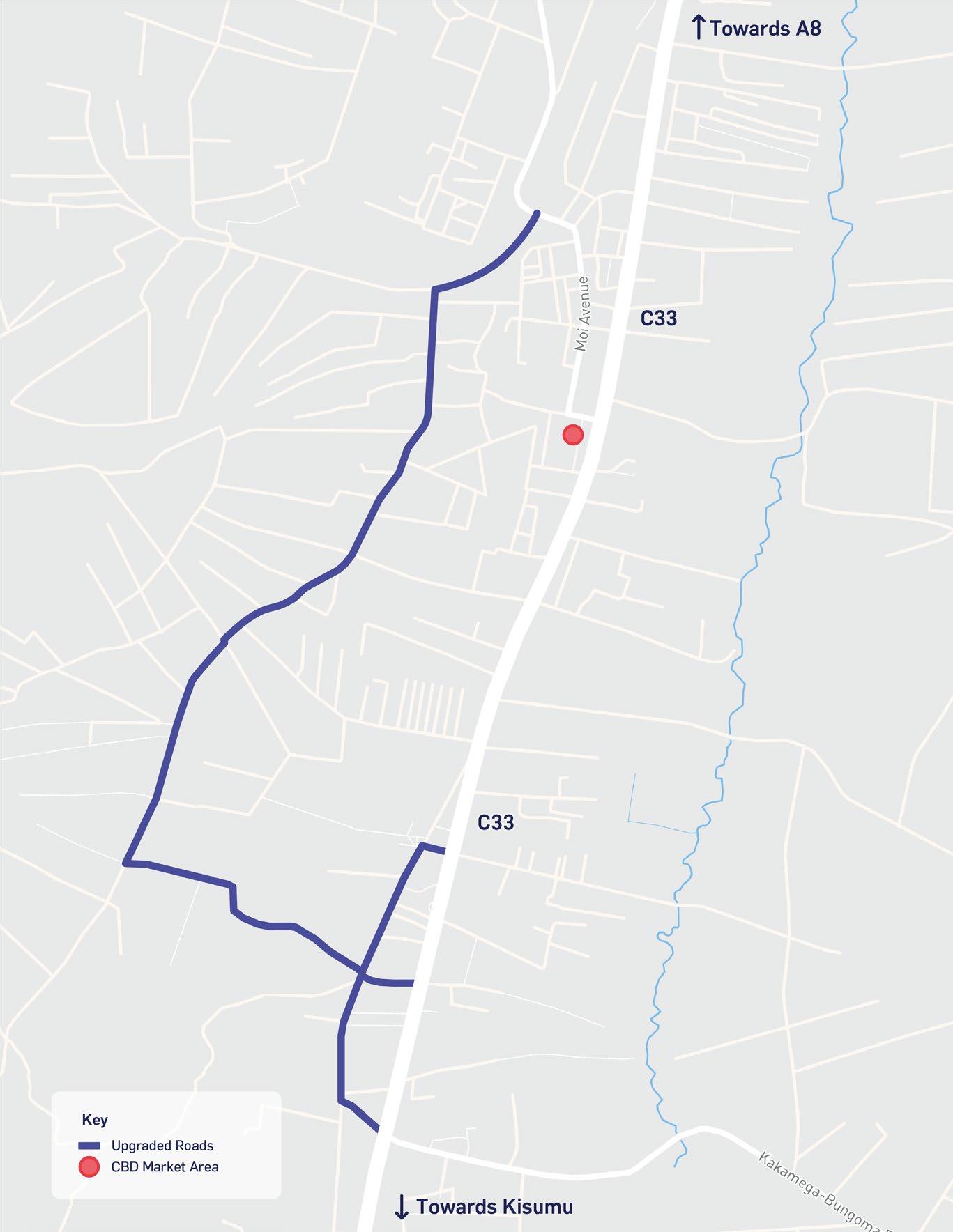
4 minute read
Table 4-9 – Project 2 Basic Analysis and Timeline
Table 4-9 – Project 2 Basic Analysis and Timeline
Challenges Data gaps
If sufficient groundwater is not available, then surface water or water from the river Nzoia will have to be used.
This will add to the cost and energy requirements as water will need to be pumped and treatment increased Groundwater depths, yields and water quality to confirm feasibility and design parameters of the systems Short term
The services would have to be developed at the same time as the Industrial Zone in order to supply the future industrial and VC activity with water, wastewater and drainage services
Time frame, key dependencies
Source: Atkins
SUED Principles
Climate change interactions and approaches
This proposal will provide a sustainable and resilient water supply for the Industrial Zone. Reduced reliance on polluted water supplies, such as the River Nzoia, and improvements to wastewater services will contribute to improved public health and reduced prevalence of diarrheal disease, with associated healthcare cost reduction which is often a significant burden on low-income groups.
Groundwater assessments should be carried out to ensure that the amount of water being extracted by the solar-powered boreholes is sustainable and does not deplete the water table. If abstraction from the Nzoia River is necessary to increase quality and quantities, a water abstraction plan will be necessary to ensure sustainable abstraction from the river. There is a risk of damage to water supply and wastewater treatment infrastructure from flooding and so flood risk assessments should be carried out. Climate Finance Options
Access to climate finance increases the capacity of projects to deliver climate mitigation and adaptation actions. There are a range of specialised funds and instruments available which could provide a source of finance for this project, including:
• The Adaptation Fund (AF)
• The National Treasury
• The Special Climate Change Fund (SCCF)
• African Financial Alliance on Climate Change (AFAC)
Section 5.5 provides more information about available climate funds in Bungoma.
Social inclusion interactions and approaches
The improvement of water provision and wastewater treatment will contribute to the economic activities in the industrial site, supporting future industrial activities. This will also contribute to improving the health of staff and local communities.
Case Study

Stabilisation pond and reed bed, Oxford, UK65
Welcome Break Oxford Motorway Services in the UK use a modified stabilisation pond and reedbed system in conjunction with a basic Submerged-aerial filter sewage treatment plant to treat the wastewater from the whole site. The plant produces high-quality effluent that meets the required discharge standards. The site has also become a wildlife haven and sanctuary, attracting birds, ducks, deer, butterflies, and dragonflies.
65 Cress water solutions, Case studies – Oxford motorway services (2022), Available at: https://cresswater.co.uk/case-studies/ oxford-motorway-services/, (Accessed: 10/02/2022). 4.2.5.3 Project 3: Solar refrigeration (cold stores) Project Overview
Post-harvest and post-catch losses are a significant problem across the agricultural sector. For agricultural produce, cold stores can extend the shelf life of perishable food by between two and 21 days, reducing post-harvest losses by up to 80% and increasing small farmers’ income by 25%66 .
This infrastructure project aims to provide solar-powered cold stores in agricultural hub locations to support local farmers who currently have no access to a cold storage and therefore lose part or all of their product due to spoilage.
Modular solar-powered cold stores are becoming popular in small farming communities where grid electricity is not available or expensive. They work on a subscription model whereby farmers pay a flat daily rate for each crate of food they store (about KES 5 per kg). Some providers use mobile phone apps to communicate to farmers about the availability of space in the store and to process payments. The revenue created goes towards maintenance of the facility and employment of a facility manager. Many providers target job creation for women.
This project will provide a number of small, solar-powered cold stores (a half to full-size shipping container) that will act as hubs to local farmers who currently have no access to refrigeration services. All farmers can use the facilities whether they are linked to the VCs or not. This project has several proposed components:
> The size and location of the facilities will be based on determining the following: > The number, size and location of arable farms and livestock holdings and their seasonal outputs, the current status of their storage facilities and refrigeration needs, and current produce sales practices; > Preparation of designs for solar refrigeration systems as well as a procurement and deployment plan; > Selection of land and deployment of systems to selected locations; to include construction of facility, roll-out of payment mechanism, selection, and training of managers; and > Capacity building with selected local people to ensure maintenance and operation of systems.
Location
> The locations of these projects will be determined by a feasibility study. > Linkages > Which existing projects/proposals (if any): no links to other existing projects. > Other SUED infrastructure/urban projects: the project links to the dairy VC. > Links to SUED principles: resilience, resource efficiency and sustainability.
Category
> Feasibility study > Capital investment: new
66 Cold Hubs, The Solution: Walk-in, solar-powered cold stations for 24/7 storage and preservation (2022), Available at: https://www.coldhubs.com/, (Accessed: 15/02/2022).










